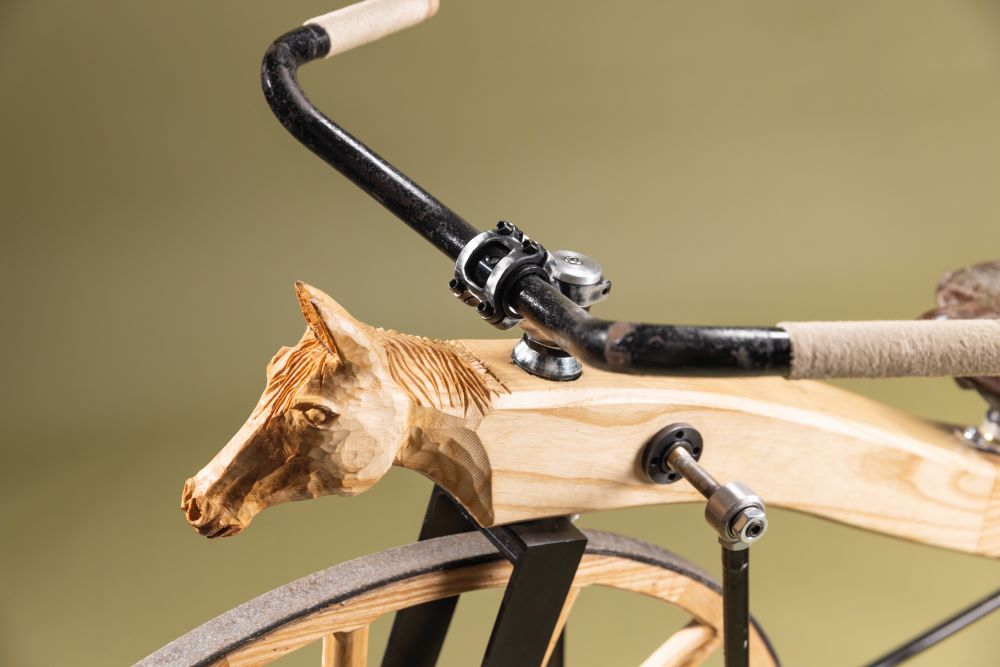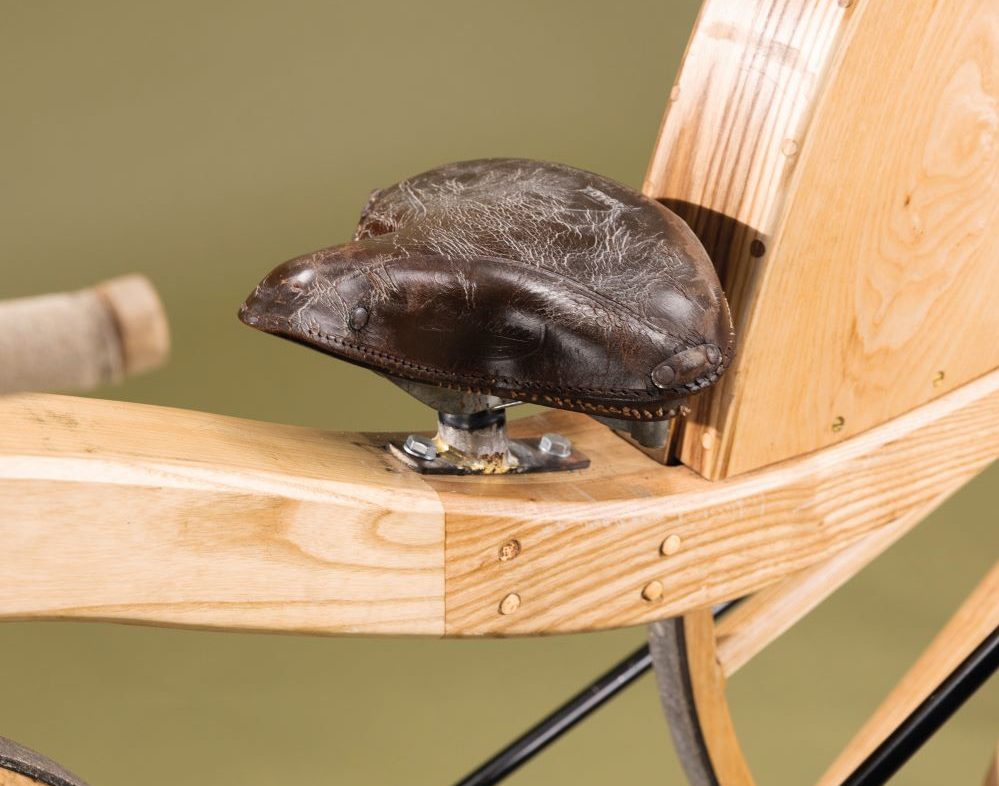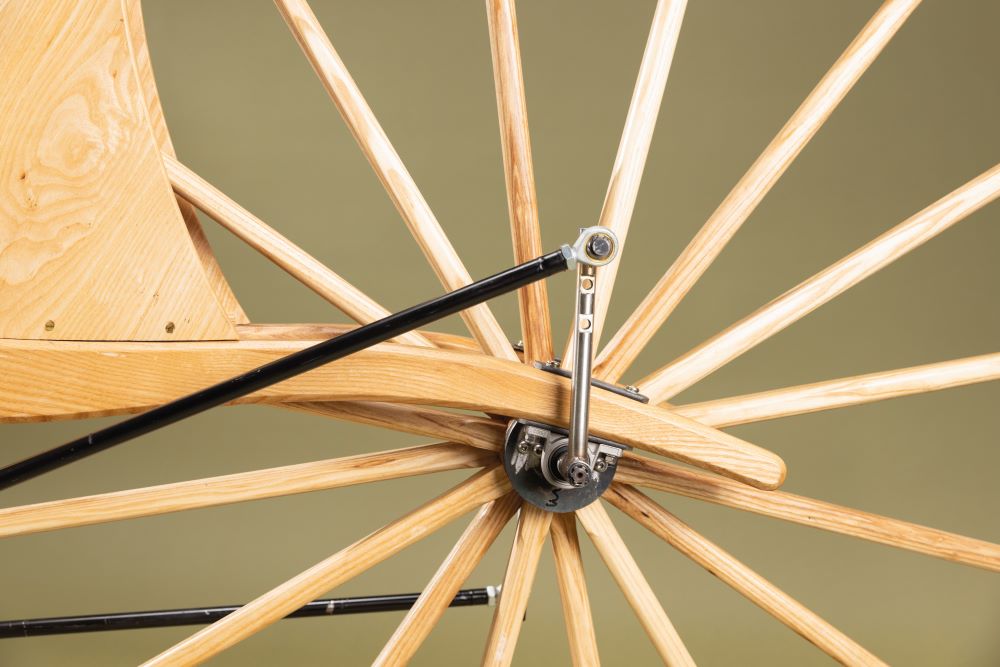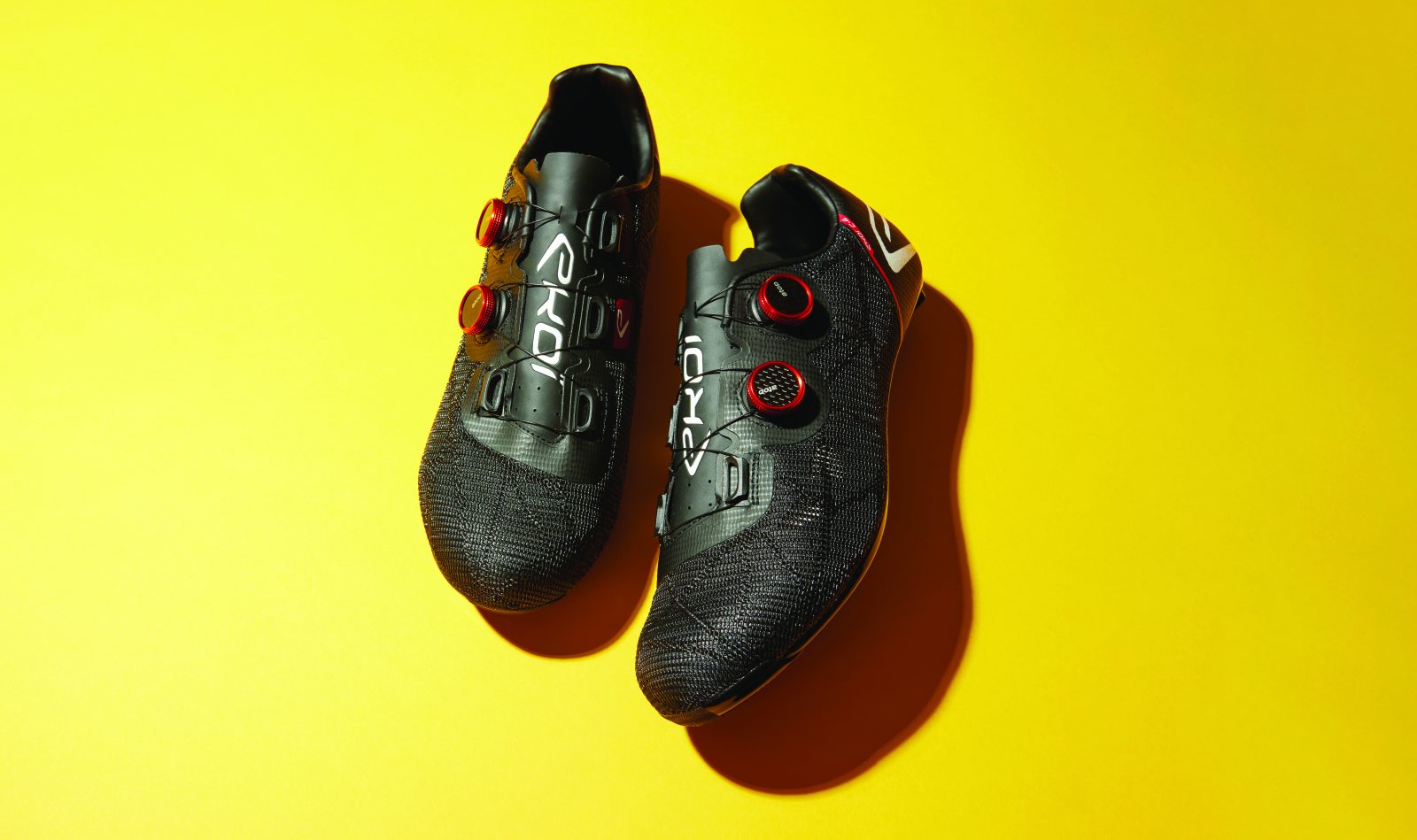Over 180 years ago in Scotland, the first pedal bicycle was built, complete with wooden wheels and a treadle linkage mechanism. Now the ‘Forgotten Legend’ has been revived thanks to cycling clothing brand Endura and two craftsmen

Words EMMA COLE Photography CONNOR MOLLISON
It’s 1839. A man swings one leg over a saddle on a long wooden frame; one extremely large wheel is behind him and a smaller wheel straight ahead.
He pushes off the ground with his feet and then places them in front of him on two wooden pedals either side of the frame, pushing them back and forth, driving the machine forward.
The man is Kirkpatrick Macmillan and he has just taken the first ever ride on his new invention: the pedal bicycle.
Born in the Dumfriesshire village of Kier on 2nd September 1812, Macmillan was the son of a blacksmith and followed his father’s footsteps into the trade.
At the time, foot-propelled vehicles called hobby-horses or swiftwalkers, powered by the rider’s feet pushing off the ground, had been around for a couple of decades, but Macmillan realised he could improve the machine.
He built his own version and added a treadle linkage mechanism – essentially push and pull pedals.
In 1842, it was reported that Macmillan cycled his creation more than 60 miles from his home in Thornhill, Dumfries and Galloway, all the way to Glasgow, his longest and most historic ride.
There are no lasting remnants of the actual bike, but Macmillan’s legacy lives on thanks to the work of two Scottish craftsmen.
Remaking history
It has been over 180 years since Macmillan’s endeavour, and to mark last year’s UCI World Championships coming to Glasgow, Scottish cycling brand Endura decided to recreate the iconic bicycle, in partnership with boatbuilder Tim Loftus and bikebuilder Steven Shand.
‘The aim was to build a replica of the original bike and then ride it from Dumfries to Glasgow in the footsteps of Macmillan,’ says Shand, who founded Shand Cycles but now builds custom steel frames under the name Willow.
‘But it became apparent quite quickly that this was going to be a monumental task for somebody to do, and the bike wouldn’t have lasted.
‘On the actual bike there were no bearings. Everything was steel shafts in a wooden hole so we had to work out how much we could stick to the original bike but make it last.
We built the replica dimensionally as close to the original as possible.
The mechanics would have been identical, the wooden wheels the same, but we upgraded certain parts – the parts you can’t see. ‘There are sealed bearings throughout.
The fork is steel and uses a modern headset, which is pressed into the wooden frame. The saddle is a bit of a compromise and is actually a motorcycle saddle from the early 1900s.
We also upgraded the treadle mechanism and made it out of better materials so it would last.’ Living five hours apart from each other, Loftus in Ullapool in the north-west of Scotland and Shand in Falkirk near the centre, the two set about working together but separately.
‘The plan was for me to do the original design and drawings, and for Tim to build from that,’ says Shand. ‘While he was building his parts, which were the frame and the wheels, I was building the mechanical parts in parallel.
‘But before we even got to that, we did quite a lot of research into the bike. The thing that’s a little bit tricky with this is that the actual bike that Macmillan built doesn’t exist anymore, but there is a replica of it, which was built in around 1850 and sits in the Dumfries Museum.
It’s almost the definitive original bike, even though we talk about it as a replica.

‘I spent a few days in the museum taking dimensions and photos of the original replica bike, and then, as we wanted to build it in a way that was more modern, we created a 3D CAD model of it.
This was important as it meant that we knew the wooden parts built by Tim would seamlessly integrate with the work I was doing.’
Wooden heart
As a boatbuilder, Loftus is well used to working on one-off projects and has, in fact, built a few wooden bikes, albeit fast, lightweight and with hollow tubes.
‘The choice of wood was straightforward, because ash is pretty standard for vehicle and bike construction,’ says Loftus.
‘Ash is strong and resilient; it will take a good bend and always spring back out. The only bits that aren’t ash are the hubs. They are elm, as that was traditional for cart wheels. As elm grows, instead of splitting the grains, they twist and interlock with each other.’
As this was Loftus’s first attempt to build wooden wheels, he went looking for guidance from the past, but found it tricky to get hold of information on traditional methods.
‘Historically the wheelwrights were very secretive,’ he says. ‘They didn’t want boatbuilders or cabinet makers making wheels so they kept sneaky details to themselves.
‘You have about 50 individual joints that all have to come together in one go. You can’t get one wrong and adjust it, as that would throw the others out, and you’d be chasing your tail forever.
‘The steel tyre is the essence of the wheel. You don’t need glue to hold the wooden parts together; the wheel relies on this steel tyre that you heat up in a fire to expand it, and then cool so that it shrinks to hold the wheel together.
It’s a very quick process – you’re done and dusted in a minute or so.
That said, in total the wheels took about a week each to make.
‘The back wheel is 42 inches, which is truly enormous compared to the norm of 29 inches these days. The side loads that it experiences make it wobble all over the place.
With the ash being so resilient, it doesn’t actually matter as long as you can arrange enough clearance of everything to cope with the wobble.’
Push-me-pull-you
The key mechanism of the bike is the treadle linkage, made from mostly 16mm steel tubing.
Although the bike was the first-ever pedal bike, the way the pedal system works is quite different to what we are used to today.

‘It’s a one-to-one propulsion system, so each cycle of your foot moving forward then back will rotate the rear wheel once and so will move you forward a little more than three metres,’ explains Shand.
‘It’s almost like you are running along with a bike underneath your legs, and instead of your feet being on the ground, your feet are on the treadle pedals. Your feet are swinging back and forward rather than moving round and round.
‘Once the bike builds up any kind of speed or momentum, your input on the treadles at that point is minimal.
You quite quickly become a passenger and, because it’s equivalent to a fixed gear bike, you can’t freewheel.
All you’re really doing is keeping the momentum going.’ Loftus adds, ‘The first thing is that you have to not think that you’re riding a normal bike.
Your natural instinct is to try to turn the pedals in a rotation, but because they’re treadles and they’re just pushing backwards and forwards, you have to disengage your brain.
‘The key is to scoot it along with only one foot on the treadles and let that get used to being pushed back and forward. And then once you’ve got that, it’s easy to ride.’
Riding a legend
As part of the project, Endura organised a re-enactment of Macmillan’s historic 60-mile journey from Thornhill to Glasgow in August, coinciding with the UCI World Championships.
The ride, which included British mountain biker Mikayla Parton and Scottish sporting legends Ally McCoist (football) and Kenny Logan (rugby), traversed Macmillan’s original route and took in sites such as Courthill Smithy, Macmillan’s workshop where he built the bike.
‘We hadn’t ridden it much before the ride with Endura,’ says Shand.
‘I had taken it out on two or three little test rides just to check everything worked, but seeing the first Endura athlete on it was pretty terrifying.
‘I’ve been building bikes for 20 years now, and you get a feeling for what works and what doesn’t.
Usually when someone asks me to build them a bike, I know what tubing to use and the construction methods, and I’ll be 100% confident that when you ride the bike it will do exactly what you want it to, and you will ride off into the sunset and everyone will be happy.

But with this bike it was a case of, “I hope it works.” We had never done anything like this before so were asking ourselves, “How strong are the wheels? How strong is the frame? How difficult is it going to be to ride?”
But luckily it all went really well. ‘As soon as you jump on the bike, you think, “Wow, this is hard to ride, it feels very different,”’ adds Shand.
‘The biggest thing that stuck out to me was that the pedals themselves sit either side of the front wheel, which means that the front wheel doesn’t really turn.
There is very little axis of rotation on the front wheel – it’s probably two or three degrees each side.
‘When you’re actually riding the bike, it’s not much of a big deal, but it becomes a real pain when you want to move it around or have it facing the other direction.
There is no small turning circle. The slow speed turning manoeuvrability was a real nightmare, but it was a really fun project to do and it was a privilege.’
Loftus agrees: ‘It’s not often you get to do a one-off project like this. It’s one beautiful piece of history.’
Emma Cole is features writer at Cyclist, which produces a one-off project every month
By the numbers
1839 – Year Kirkpatrick Macmillan created the first pedal bike
60 – Miles Kirkpatrick Macmillan rode from Thornhill to Glasgow in 1842
200 – Hours of work to create the replica bike
4 – Months it took from concept to creation
25 – Approximate weight of the bike in kilograms
1,067 – Diameter of rear wheel in millimetres
836 – Diameter of front wheel in millimetres
1,254 – Wheelbase length in millimetres



